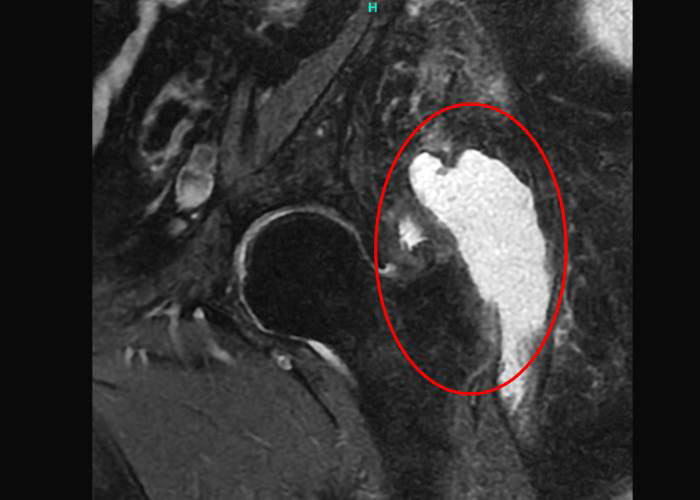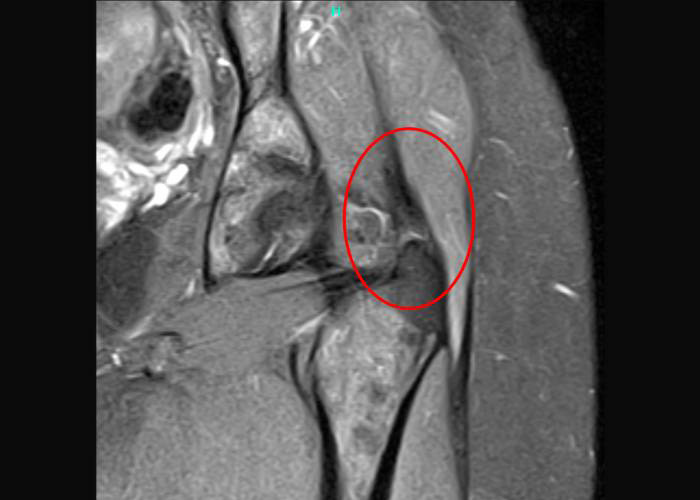Hip Abductor (Gluteus) Tendon Repair Surgeon
A blunt force trauma, such as a football tackle or fall directly on the hip, can cause the connecting tendons to be partially or completely detached from their attachment site on the femur. This is called a hip abductor tear, also a gluteus tear. If you have torn your hip abductor, you should seek an orthopedic hip expert as soon as possible. A hip abductor, or gluteus tendon repair be done endoscopically (minimally invasive technique) or may require an open incision. Doctor Prem Ramkumar, hip abductor surgeon, has the experience and expertise in surgical repair of hip abductor tendons. He is located in Long Beach and serves patients in Los Angeles, Orange County, and surrounding Southern California areas. Contact Dr. Ramkumar’s office today.

What is a gluteus medius or gluteus minimus tear?
Hip abduction is the movement of the leg away from the middle of the body. There is a muscle group in the buttocks, known as the hip abductors, that work collectively to perform this movement. These four muscles include the gluteus maximus, gluteus medius, gluteus minimus, and the tensor facia lata. In addition to hip abduction, these muscles provide the ability to stand, walk, and rotate the legs. Although the hip abductors are relatively strong, they are still susceptible to injury. A blunt force trauma, such as a football tackle or fall directly on the hip, can cause the connecting tendons to be partially or completely detached from their attachment site on the femur (thigh bone) – although this is rare. More commonly, degenerative conditions such as osteoarthritis and bursitis can also contribute to a hip abductor tear. Of the four hip abductors, the gluteus medius and gluteus minimus are most frequently injured and are responsible for weakness, pain, limping, and loss of balance and body control.


What is the treatment for a hip abductor (gluteus) tear?
In the event of a small hip abductor tear where the tendons remain intact and mobility is not affected, conservative therapies may be sufficient. It is strongly recommended to avoid any major physical activity or unnecessary hip movements during the healing process. Pain and inflammation can be managed with a combination of rest, ice, and non-steroidal anti-inflammatory medications (NSAIDs). When appropriate, participation in a physical rehabilitation program can also reduce pain and improve your range of motion and mobility. You may also be eligible for a hip injection to help heal and alleviate pain.
However, if there is a complete tendon rupture or gluteus tear and if conservative therapy has been unsuccessful, surgical repair may be beneficial to reattach the tendon to its attachment site. This surgical reattachment is performed with an open surgical technique. There are a number of factors, such as the injury severity, patient’s age, medical history, activity level, tendon quality, and recovery goals that are considered when developing an appropriate treatment plan. Dr. Prem Ramkumar, hip abductor (gluteus medius, gluteus minimus) tear surgeon, is located in Long Beach and serves patients in Los Angeles, Orange County, and surrounding Southern California areas, who have experienced a hip abductor tear and are in need of surgical repair.
How is an open hip abductor repair performed?
This surgical procedure requires an incision over your greater trochanter for visualization of the entire hip abductor insertion site. Anchors are placed and the tendons are retrieved and fastened down to the anatomic footprint.
When a significant amount of time passes between the injury and surgical repair, patients may experience substantial muscle atrophy and tendon retraction that can make for a difficult repair. If this is the case, Dr. Ramkumar may prefer an open reconstruction of the hip abductor. This procedure uses a tendon graft from either the patient (autograft) or donor tissue (allograft) to lengthen the retracted tendon or reconstruct the tendon in its entirety.
What is the recovery period like after hip abductor repair?
The recovery period following a a gluteus medius and/or gluteus minimus repair requires as much meticulous postoperative care by the patient as the surgery itself. Most patients can anticipate normal walking by 3 months but a full recovery by 6 to 9 months. In general, patients can expect the following recovery timeline:
- Restricted foot-flat weight-bearing with crutches or a walker in a brace in 15° abduction, 30-90° flexion, neutral rotation. Please sleep with this brace on for the first 5 days after surgery. No avoid active abduction and internal rotation and no passive adduction or external rotation for the first 6 weeks to give the abductors opportunity to heal. No physical therapy during this time is allowed.
- After the first 6 weeks, the brace may be removed and weight bearing can be progressed with assistive device weaning. At this time, formal outpatient physical therapy will be initiated with an emphasis on gait training to normalize walking, but no active adduction past neutral will be allowed during this time.
- After 12 weeks, emphasis will shift towards range of motion and strengthening. This process can take an additional 3-6 months to start returning to full activities without precautions.

